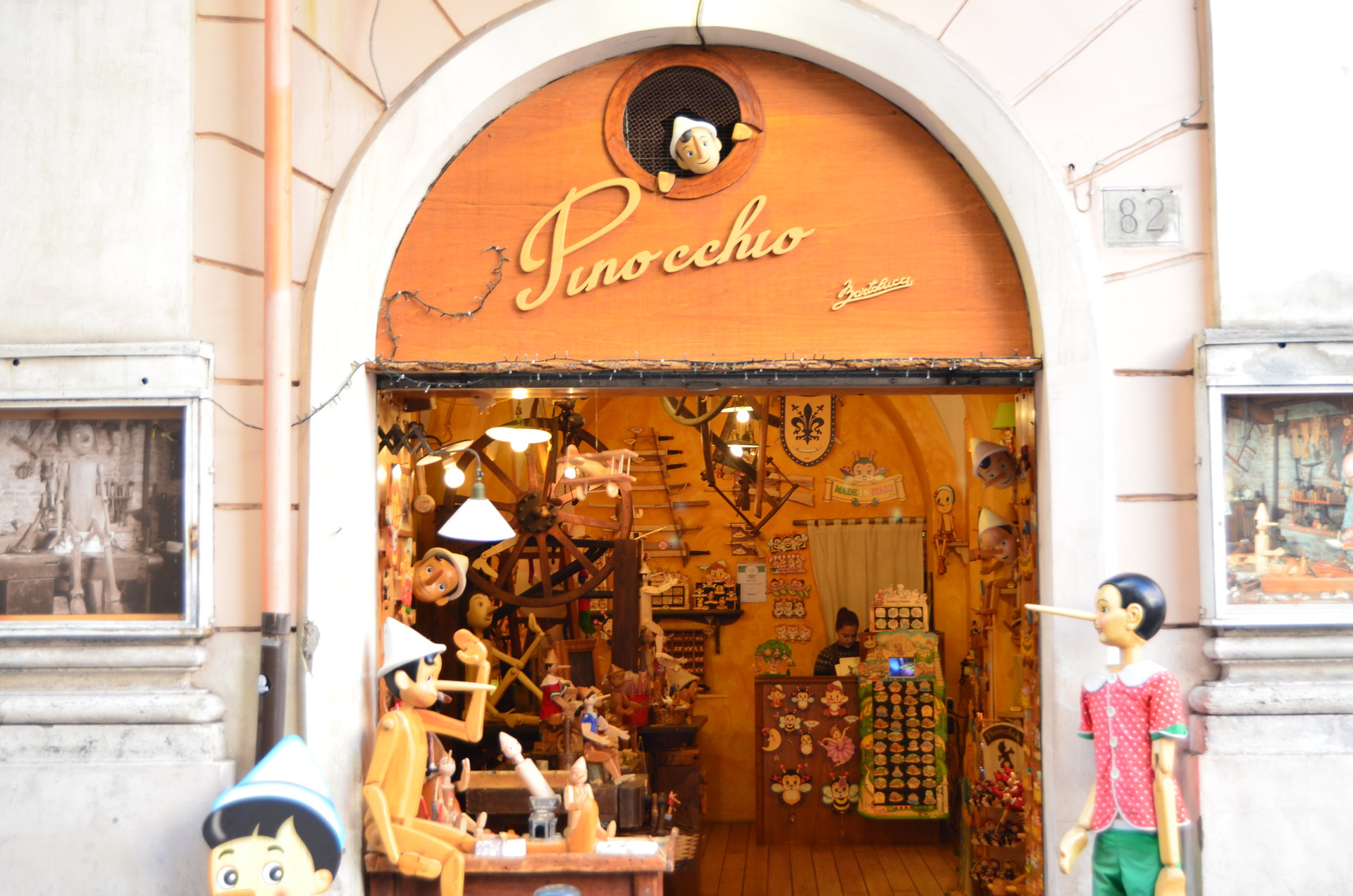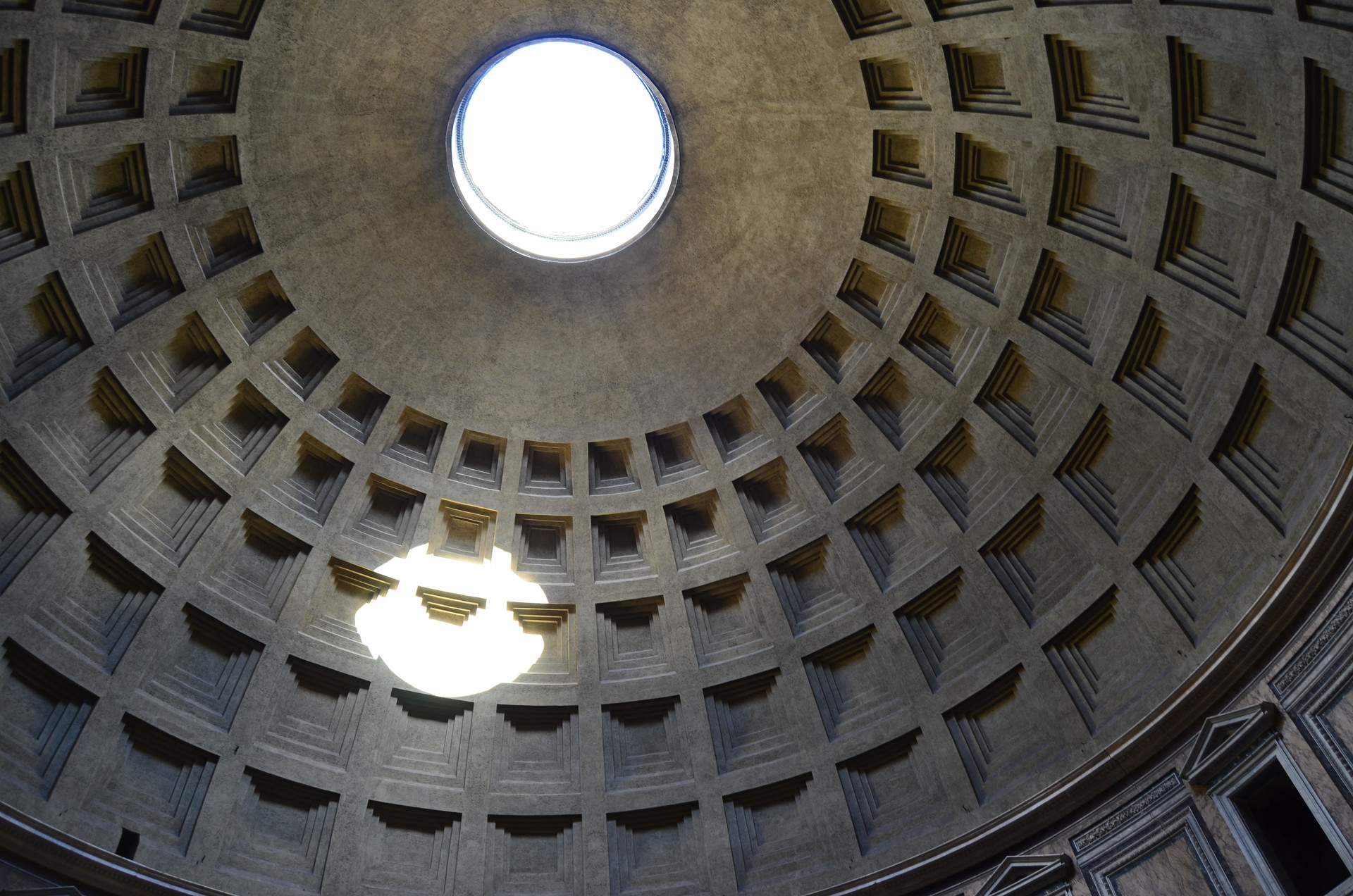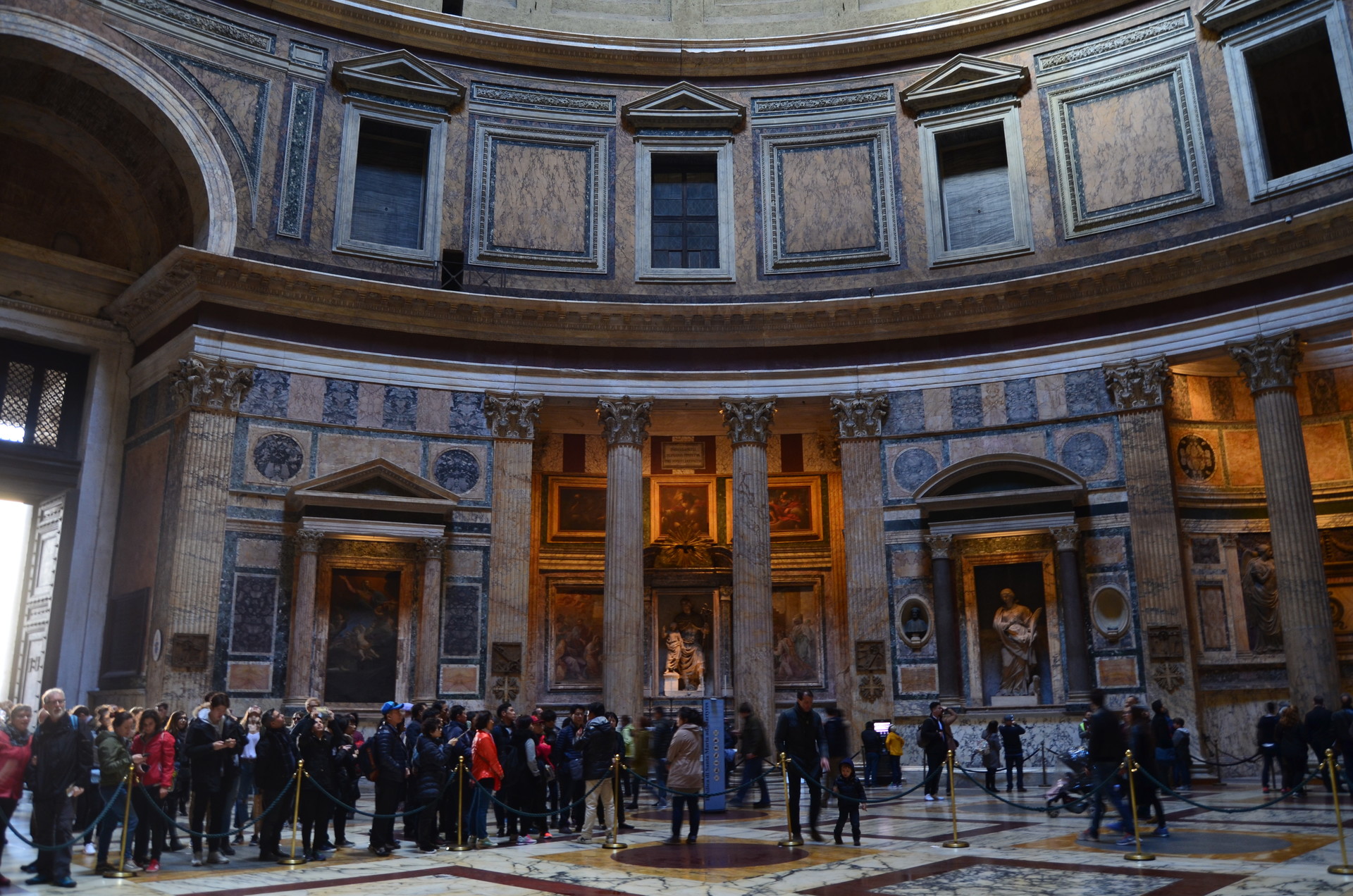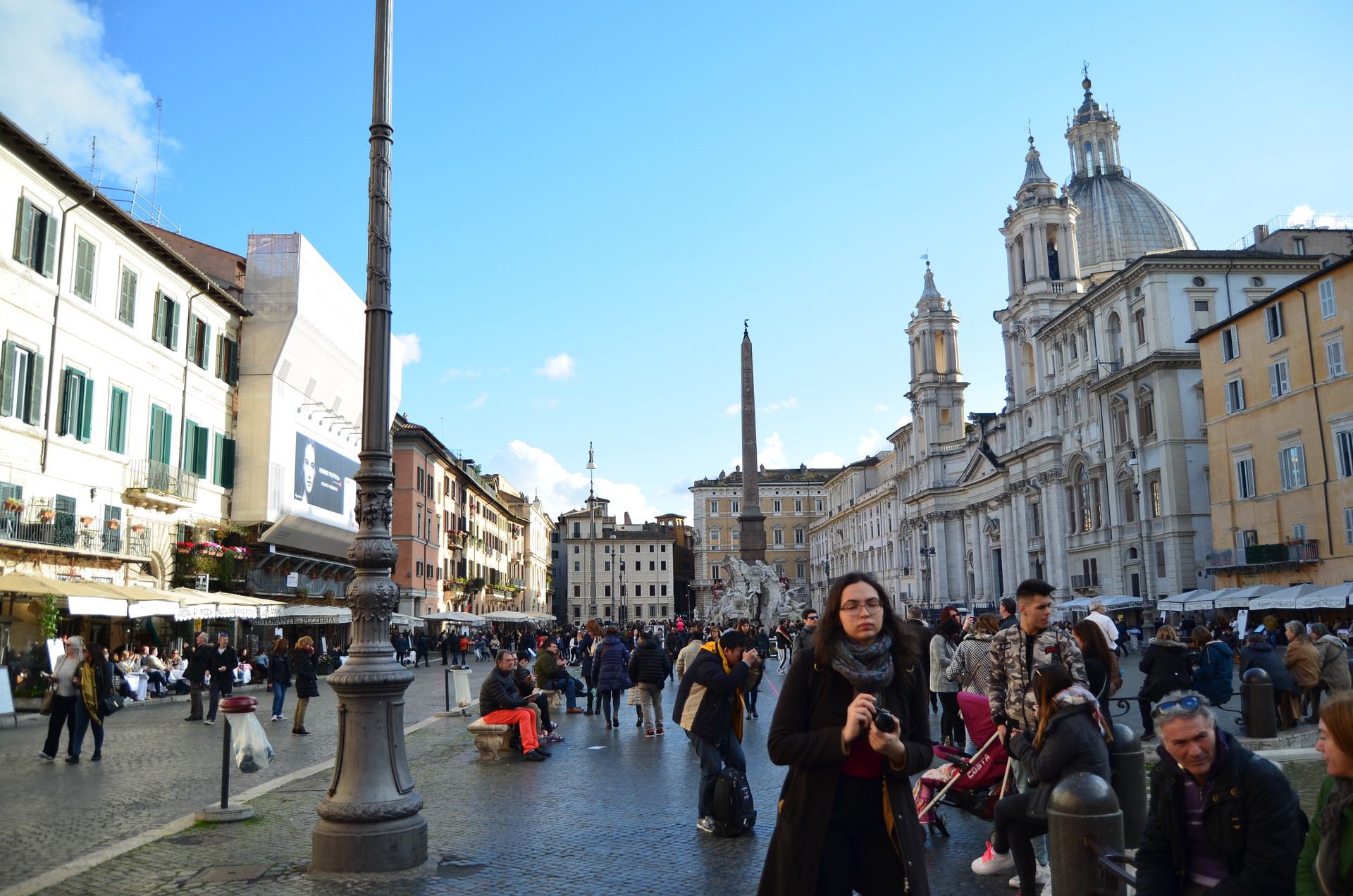overwhelming architecture
Remembering Rome: The great Pantheon
In the day dedicated our last destination into the Roman antiquities is the Pantheon, and not the Partheon – the greek temple dedicated to all gods placed on the Greek Acropoles - with which people, including myself tend to confuse it.
From the Roman Forum to the Pantheon and through the attractive streets and little shops

We find our way out of the Roman Forum and we are walking slowly on the interesting streets of Rome, looking right and left to the small specific architectural aspects of the city, entering some small and nice shops like „Pinocchio”, a handmade toy shop that gets our attention so much, or eating a delicious traditional italian ice cream.
Where is the Pantheon situated and when is open for visiting?
Soon, we are in front of the building we have been searching for in Piazza della Rotonda, where the Pantheon is located. Another nearby square is Piazza Navona, which we decide to visit after we get in the Pantheon.
The Pantheon is open for visiting from Monday to Saturday between 08.30 AM to 19.15 PM. On Sunday is open from 09.00 AM to 17.45 PM.

There are many tourists here taking in consideration the fact that the construction is one of a kind in the world being at same point considered the only and biggest antique concrete structure that survived very well over the years that have passed and until today.
Piazza della Rotonda and its monuments
In Piazza della Rotonda we also admire an obelisk, which as any other such monuments seen around Rome had been brought to the italian capital during ancient times when the Roman Empire expanded over the continents. The obelisk is dedicated to the Egyptian god Isis.
I notice that around Rome is a cultural thing to have and combine the old pagan architectural elements with the christian ones and I think is a remarkable action coming from Rome to not erase the past but to preserved it and presented to its people so they can understand better the nation's history. I appreciate very much the italian people for keeping in this way the culture alive and transparent.
The exterior view of the Pantheon
Yes, the Pantheon is impressive, but from the outside if people don’t know anything about it they can say that is not the greatest building they have seen because the exterior has a pretty austere look.
The main facade is dominated by large scale corinthian columns on which lays a cornisa with a strange inscription saying „ma.grippa.l.fcos.tertivm.fecit” which I discover that it means „Marcus Agrippa, son of Lucias made the building when was consul for the third time”, here Agrippa being the commander of the temple back in the Antiquity.
So, people might think that they are about to enter a temple, but inside they will get a surprize, and kind of a big one.
The impressive interior: The largest dome I’ve ever seen
There is no entry fee for visiting the Pantheon at all times. It is totally free which is a great thing for me.
As I get inside the Pantheon my eyes cannot look down, only up to the impressive ceiling. I am totally amazed by the image of the large concrete dome covering the construction.

It feels mind blowing to think that such architectural structure was built so many years ago with less technology than today. The architects, constructors and the artists did a very good job in raising the building.
The strange oculus
The ceiling is very high and it makes people to feel small and overwhelmed. The round dome is coffered and has a circular opening in the middle from where the light enters into the building and is moving throughout the day depending on the position of the sun.
Besides the entrance’s door, this is also the one and only source of natural light that the Pantheon has, there are no any other windows or openings through the walls, thus, the building is not darken, but pretty well lightened, which is so cool.
The oculus, as it is often called, doesn’t have a transparent glass, is really an opening, so when it rains, the waters gets into the building through here. But this fact doesn’t seems to be a problem, because the floor is designed in a tilted way so that the water is not standing, but going in some drains and then out.
What else is to be seen inside the Pantheon?
After I get tired for standing with my head up looking at the "rotunda", the world’s largest concrete dome, my eyes go down to the walls which are full of paintings, statues, decorations and burials.

Speaking of that, I find out that here are buried important people in italian history such as the painters Raphael, Annibale Carraci, Baldassare Peruzzi and also the Kings of Italy.
Even though, there are many artworks and decorations around the interior space, the image and the feeling that I get from it is quite harmonic and balanced because the overall aspect of the inside has been designed thoughtfully on the base of circles and squares.
The circular dome has been divided into squares while on the marble of the floor are imagined also geometrical shapes depicting squares and circles. So, the ceiling matches perfectly with the floor.
The color range gives a boost and contributes to the creation of a harmonical space being focused on some specific colors like yellow, orange, deep reed, pink, many tones of brown and grey.

In comparison with the outside aspect of the building, the interior is rich in colors, decorations, statues and small details that are waiting to be discovered.
The paintings and the sculptures are representing biblical characters due to the fact that today the placed has been transformed into a Catholic church dedicated to Saint Mary and Martyrs and named "Santa Maria Rotonda".
Actually, since the Medieval Ages, the Pantheon has been used as a christian church. On Sunday and on important holidays here are held worships and weddings.
It is kind of difficult to leave the wonderful and impressive construction of the Pantheon, but there are many other interesting destinations that are waiting for us outside these concrete walls that are truly protecting a big treasure. After one hour or more of staring around the building my friend and I are leaving and heading towards Piazza Navona.
Last but not least, Piazza Navona
Our day of exploring finishes in Piazza Navona which is much more interesting then we have expected. Around the large city square there are many buildings built in a baroque impressive way, but the attraction that stands out the most is of course the famous "Fontana del Quattro Fiumi" translated as "The Fountain of the four rivers".

Here, as it is in Piazza della Rotonda, has been placed over the fountain an egyptian obelisk. The beautiful fountain and its sculptures had been created in the 17th century by the well known and much appreciated italian artist Bernini.
As we are getting closer to the fountain, Bernini's talent and craftmenship in carving starts to be visible. He created four figures representing four main rivers of the continents: The Gange, The Nile, The Danube and Rio de la Plata.
Besides this eye catching monument, we see here, in Piazza Navona, two other fountaines, namely "The Fountain of Neptun" and "Fontana del Maro", both designed and made by Giacomo della Porta. Suddenly, I remember that I had been learning about these fountains and their creators in my art history lessons and again, I feel happy and thankful for having the chance to see directly the artworks. It gives me a very strange and unique feeling which I think is of accomplishment.
Even if is the end of the day and is starting to get dark outside, there are still lots of people in the public city square, both tourists and locals.

The atmosphere is very nice, chatty and chill. Many children are playing and running around and people are starting to slow down, they are walking more slowly then during the day ( when is so much agitation on the streets and inside the main attractions due to the large wave of tourists who want to see as much as they can without thinking more of the other people around them ) and are finally stoping to rest for same time.
We are also tired and our feet are hurting for walking all day long around the Roman antique culture, thus, we feel very blessed and thankful for having the opportunity to explore such a wonderful european capital full of history, great artworks and beautiful people. We think that the destination I have been describing in this article are for sure worth seeing and found out more about in Rome.
Photo gallery
Content available in other languages
- Italiano: Architettura maestosa
Rate and comment about this place!
Do you know Pantheon? Share your opinion about this place.






















